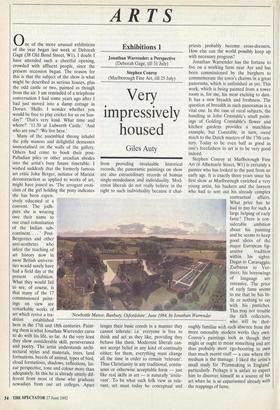ARTS
0 ne of the more unusual exhibitions of the year began last week at Deborah
Gage (38 Old Bond Street, W1). I doubt I have attended such a cheerful opening, crowded with affluent people, since the present recession began. The reason for this is that the subject of the show is what might be described as serious houses, plus the odd castle or two, painted as though from the air. I am reminded of a telephone conversation I had some years ago after I had just moved into a damp cottage in Dorset. 'Hullo. I wonder whether you would be free to play cricket for us on Sun- day?' That's very kind. What time and where?' 11.30 at Lulworth Castle.' And who are you?' We live here.'
Many of the assembled throng inhabit the jolly manors and delightful demesnes Immortalised on the walls of the gallery. Others had come to book their post- Palladian piles or other arcadian abodes into the artist's busy future timetable. I wished suddenly that the formerly famous art critic John Berger, initiator of Marxist deconstruction as applied to works of art, might have joined us. `The arrogant eroti- cism of the girl holding the pony indicates she has been expen- sively educated at a convent. The jodh- purs she is wearing owe their name to our cruel colonisation of the Indian sub- continent. . . . ' Post- Bergerites and other anti-aesthetes who infest the teaching of art history now in most British universi- ties would surely have had a field day at the present exhibition. What they would fail to see, of course, is that many of the 17 commissioned paint- ings on view are remarkable works of art which revive a tra- dition established here in the 17th and 18th centuries. Paint- ing them is what Jonathan Warrender cares to do with his life, so far. At the very least they show considerable skill, perseverance and poetry. The artist understands archi- tectural styles and materials, trees, land formations, breeds of animal, types of bird, cloud formations, shadows, reflections, lin- ear perspective, tone and colour more than adequately. In this he is already utterly dif- ferent from most of those who graduate nowadays from our art colleges. Apart
Exhibitions 1
Stephen Conroy (Marlborough Fine Art, till 25 July)
Very impressively housed
Giles Auty
from providing invaluable historical records, the panoramic paintings on show are also extraordinary records of human single-mindedness and individuality. Mod- ernist liberals do not really believe in the right to such individuality because it chal- Wewbottle Ma nor, Banbury, Oxfordshire, June 1984, by Jonathan Warrender lenges their basic creeds in a manner they cannot tolerate: i.e. everyone is free to think and act as they like, providing they behave like them. Modernist liberals can- not accept belief in any kind of continuity either; for them, everything must change all the time in order to remain `relevant'. Thus Christianity in any traditional, contin- uous or otherwise acceptable form — just like real skills in art — is naturally 'irrele- vant'. To be what such folk view as rele- vant, art must today be conceptual and priests probably become cross-dressers. How else can the world possibly keep up with necessary progress?
Jonathan Warrender has the fortune to live on a working farm near Ayr and has been commissioned by the burghers to commemorate the town's charms in a great panorama, which is unfinished as yet. This work, which is being painted from a tower room is, for me, his most exciting to date. It has a new breadth and freshness. The question of breadth in such panoramas is a vital one. In the case of rural subjects, the handling in John Constable's small paint- ings of Golding Constable's flower and kitchen gardens provides a matchless example, but Constable, in turn, owed much to the Dutch masters of the 17th cen- tury. Today to be even half as good as one's forefathers in art is to be very good indeed.


















































 Previous page
Previous page